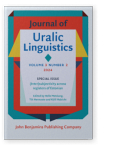Introduction
(Inter)subjectivity in Estonian registers
This issue focuses on a little-studied aspect of (inter)subjectivity (S/ IS) in language: the expression of S/ IS in
different registers. In the introduction, we overview the background and approach, describe the central registers in connection
with using S/ IS devices, and correlate the choice and frequency of S/ IS devices with the situative features of registers. The
introduction also includes a brief overview of the articles in the issue.
We have studied three groups of S/ IS devices: (1) pragmatic particles, (2) CTP markers based on complement-taking
predicates, and (3) modal verbs. Our central data comes from the Estonian Pragmatic Corpus. We look mainly at the expression of
S/ IS in seven registers, broadly divided into three groups: spoken, online, and printed texts.
The papers on the issue deal with the use and development of different particles in registers of Estonian and the
use of S/ IS differences between registers to develop metrics for distinguishing registers.
Article outline
- 1.About (inter)subjectivity and its study
- 2.S/ IS markers studied to compare registers
- 3.S/ IS characterisations of registers
- 3.1Everyday conversation (EC)
- 3.1.1Particles
- 3.1.2CTP markers
- 3.1.3Everyday conversation: Conclusion
- 3.2Institutional interaction (II)
- 3.2.1Particles
- 3.2.2CTP markers
- 3.2.3Institutional interaction: Conclusion
- 3.3Instant messaging (IM)
- 3.3.1Particles
- 3.3.2CTP markers
- 3.3.3Instant messaging: Conclusion
- 3.4Online comments (OC)
- 3.4.1Particles
- 3.4.2CTP markers
- 3.4.3Online comments: Conclusion
- 3.5Printed fiction (PF)
- 3.5.1Particles
- 3.5.2CTP markers
- 3.5.3Printed fiction: Conclusion
- 3.6Printed media (PM)
- 3.6.1Particles
- 3.6.2CTP markers
- 3.6.3Modal verbs
- 3.6.4Printed media: Conclusion
- 3.7Academic prose (AP)
- 3.7.1Particles
- 3.7.2CTP markers
- 3.7.3Modal verbs
- 3.7.4Academic prose: Conclusion
- 4.Comparison of S/ IS marking in registers
- 5.About the articles in this issue
- Notes
- Abbreviations
-
References
This content is being prepared for publication; it may be subject to changes.
